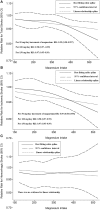The Effect of Magnesium Intake on Stroke Incidence: A Systematic Review and Meta-Analysis With Trial Sequential Analysis
- PMID: 31447767
- PMCID: PMC6692462
- DOI: 10.3389/fneur.2019.00852
The Effect of Magnesium Intake on Stroke Incidence: A Systematic Review and Meta-Analysis With Trial Sequential Analysis
Abstract
Background: The effect of magnesium on stroke has been consistently discussed less, and the results of previous studies have been contradictory. We reviewed the latest literature and quantified robust evidence of the association between magnesium intake and stroke risk. Methods: PubMed, EMBASE, the Cochrane Library, the Web of Science and ClinicalTrials.gov were searched through inception to January 15, 2019 for prospective cohort studies on magnesium intake and the incidence of stroke. Results: Fifteen studies with low bias involving 18 cohorts were entered into this study. The summary relative risk (RR) was significantly reduced by 11% for total stroke (RR: 0.89 [95% CI, 0.83-0.94]; P < 0.001) and by 12% for ischemic stroke (RR: 0.88 [95% CI, 0.81-0.95]; P = 0.001), comparing the highest magnesium intake category to the lowest. After adjusting for calcium intake, the inverse association still existed for total stroke (RR: 0.89 ([95% CI, 0.80-0.99]; P = 0.040). There was an inverse but non-significant association for hemorrhagic stroke, subarachnoid hemorrhage and intracerebral hemorrhage. The quantitative associations for total and ischemic stroke were robust. Importantly, high-risk females who had a body mass index (BMI) ≥25 kg/m2 and who were subjected to a ≥12 y follow-up exhibited a greater decrease in RRs as a result of magnesium intake. For each 100 mg/day increase in magnesium, the risk for total stroke was reduced by 2% and the risk for ischemic stroke was reduced by 2%. Conclusions: Increasing magnesium intake may be a crucial component of stroke prevention that acts in a dose-dependent manner. However, the conclusion is limited by the observational nature of the studies examined, and further randomized controlled trials are still needed.
Keywords: magnesium; meta-analysis; stroke; systematic review; trial sequential analysis.
Figures




References
-
- Meschia JF, Bushnell C, Boden-Albala B, Braun LT, Bravata DM, Chaturvedi S, et al. . Guidelines for the primary prevention of stroke: a statement for healthcare professionals from the American heart association/American stroke association. Stroke. (2014) 45:3754–832. 10.1161/STR.0000000000000046 - DOI - PMC - PubMed
Publication types
LinkOut - more resources
Full Text Sources

